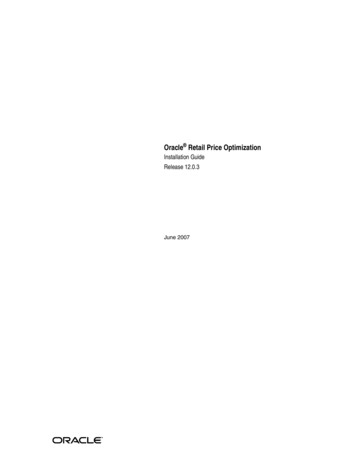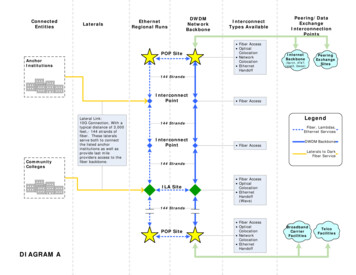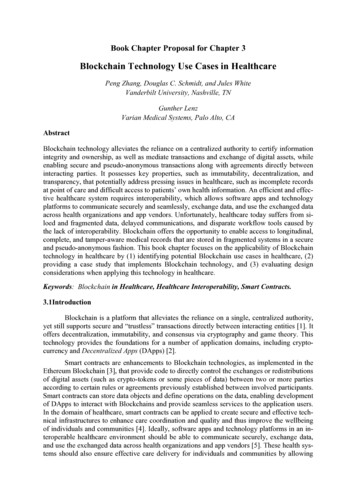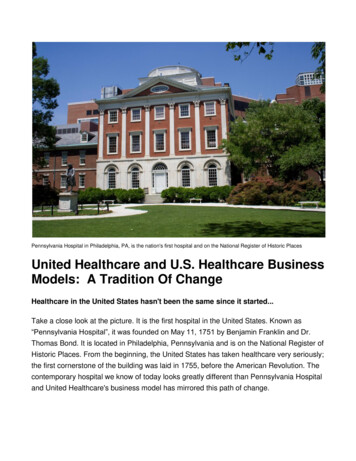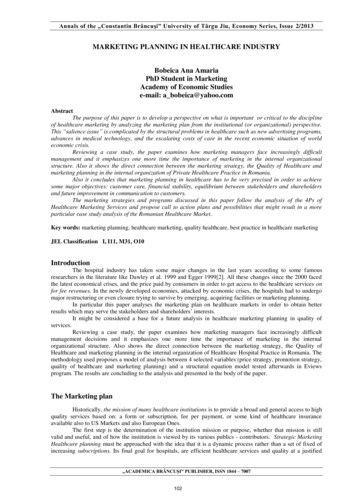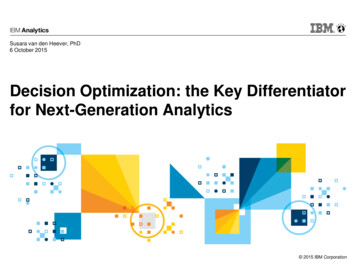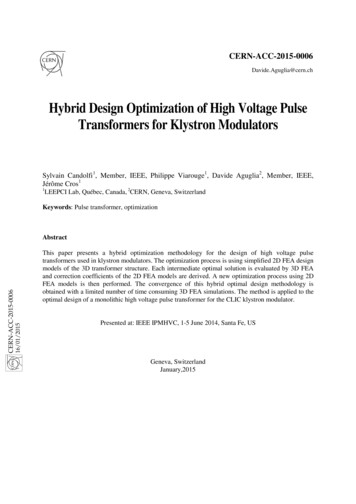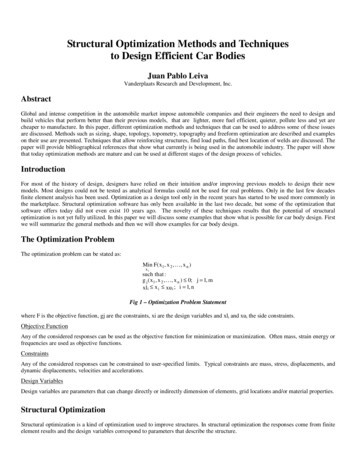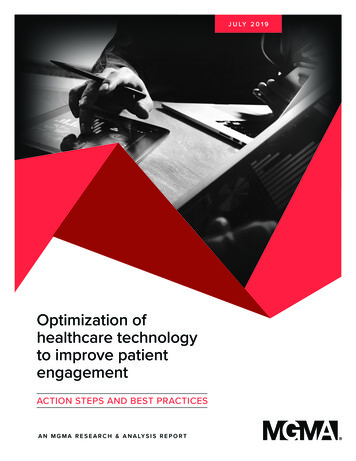
Transcription
J U LY 2 0 1 9Optimization ofhealthcare technologyto improve patientengagementACTION STEPS AND BEST PRACTICESA N M G M A R E S E A R C H & A N A LY S I S R E P O R T
Click on the sections below to navigate directly to each part of the report.TA B L E O F C O N T E N T SExecutive summary . . . . . . . . . . . . . . . . . . . . . . . . . . . . . . . . . . . . . . . . . . . . . . . . . 4Introduction: An environment for change . . . . . . . . . . . . . . . . . . . . . . . . . . . . . . . 5The technologies: The players in the game . . . . . . . . . . . . . . . . . . . . . . . . . . . . . 6Patient portals . . . . . . . . . . . . . . . . . . . . . . . . . . . . . . . . . . . . . . . . . . . . . . . . . . . . . . . . . . . . . . . . . 7Automated appointment reminder systems . . . . . . . . . . . . . . . . . . . . . . . . . . . . . . . . . . . . . . . . 8Check-in technologies . . . . . . . . . . . . . . . . . . . . . . . . . . . . . . . . . . . . . . . . . . . . . . . . . . . . . . . . . . 9Telehealth . . . . . . . . . . . . . . . . . . . . . . . . . . . . . . . . . . . . . . . . . . . . . . . . . . . . . . . . . . . . . . . . . . . . 10Digital payment options . . . . . . . . . . . . . . . . . . . . . . . . . . . . . . . . . . . . . . . . . . . . . . . . . . . . . . . . 12Data analytics . . . . . . . . . . . . . . . . . . . . . . . . . . . . . . . . . . . . . . . . . . . . . . . . . . . . . . . . . . . . . . . . 14Real time prescription pricing tools and electronic prior authorization . . . . . 16Next steps . . . . . . . . . . . . . . . . . . . . . . . . . . . . . . . . . . . . . . . . . . . . . . . . . . . . . . . . 17Conversation starter for your team . . . . . . . . . . . . . . . . . . . . . . . . . . . . . . . . . . . . . . . . . . . . . . . 17Dos and don'ts of new technology implementation . . . . . . . . . . . . . . . . . . . . . 18Research methodology . . . . . . . . . . . . . . . . . . . . . . . . . . . . . . . . . . . . . . . . . . . . . 20MGMA 2018 Exploratory Survey on Healthcare Technology . . . . . . . . . . . . . . . . . . . . . . . . . 20MGMA healthcare technology qualitative interviews . . . . . . . . . . . . . . . . . . . . . . . . . . . . . . . 22MGMA Stat . . . . . . . . . . . . . . . . . . . . . . . . . . . . . . . . . . . . . . . . . . . . . . . . . . . . . . . . . . . . . . . . . . . 233 2019 MGMA. All rights reserved.
Executive summaryThe MGMA 2018 Exploratory Survey on Healthcare Technology found the following technologies had the most positive impacton healthcare organizations in recent years: patient portals, automated appointment reminder systems, check-in technologies,telehealth, digital payment options and data analytics.These six technologies can have profound impacts on both patient engagement and practice workflow. Implementing check-intechnologies that make sense for a practice's unique patient demographics, for example, can reduce the administrative burdensand delays of processing paperwork, and simultaneously improve patient experience. While cost and adoption challenges stillexist, these technologies can lead to more efficient and effective care delivery when implemented strategically.This report provides a point of entry into these and other patient-focused, healthcare technologies allowing practice leaders toexpedite technological improvements via these five steps:1. Examine current practice environment to uncover opportunities for automation.2. Review existing technologies to determine how they address patient engagement challenges.3. Uncover best practices and common mistakes from peers.4. Identify the top three “easy wins” to pursue to achieve greater patient engagement through technology.5. Start the conversation among stakeholders and initiate change in a practice. 2019 MGMA. All rights reserved.4
INTRODUCTION:AN ENVIRONMENT FOR CHANGEPatient experience is influenced before, during and aftereach visit by how providers and staff use technology toengage patients. For customer-centric, value-basedcare, building a data platform that helps practicesenhance patient engagement allows providers tofocus on what they do best — care for people.Increased patient consumerism encourages practicesto enhance their technological capabilities. Rising costsof patient care, especially administrative costs, canbe mitigated with the appropriate technology. Moreimportant, patients can build closer relationships withtheir provider and practice staff when interactions suchas portal messaging or filling out forms are digitized,freeing up time and space for building rapport andengagement.With these pressures on the patient-providerexperience, technology companies have revved uptheir offerings to create opportunities to enhance thepatient experience. Payers expect patients to report alevel of satisfaction commensurate with value-basedcare guidelines. Technological enablement will helppractices compete effectively in the marketplace.A survey of nearly 650 healthcare consumers foundthat the digital consumer experience is of high priority.iThey’re engaged in their own care via mobile andonline technology more than ever: An engaged digitalconsumer remains a top 10 challenge in the 2018Healthcare Executive Group (HCEG) survey. Moreover,healthcare leaders surveyed in the most recent HCEGpoll shared a determination to explore how digitalhealth solutions can help respond to consumer needsand improve the patient experience pre-, during andpost-visit.5 2019 MGMA. All rights reserved.
THE TECHNOLOGIES: THE PLAYERS IN THE GAMEWho is focusing on technology? The majority of healthcare leaders. According to a 2018 MGMA Stat poll,59% of healthcare organizations invested in technology to improve patient engagement in the past year alone.59%YESIN THE PASTYEAR, HAVE YOUINVESTED IN ANYTECHNOLOGY TOIMPROVE PATIENTENGAGEMENT?AUGUST 21, 2018 POLL1,125 APPLICABLE RESPONSESOUT OF 1,152 TOTAL r MGMA Stat poll shows that 70% of healthcare leaders plan to adopt such technology in 2019 tomake their practices more efficient.IN 2019, WILLYOU ADOPTTECHNOLOGYTO MAKE YOURPRACTICE MOREEFFICIENT?TOP 5 TECHNOLOGIESUNSURE19%NO11%YES70% NEW/UPGRADED EHR KIOSK/IPAD CHECK-IN TELEHEALTH PATIENT PORTAL AUTOMATEDREMINDER SYSTEMNOVEMBER 27, 2018 POLL1,050 RESPONSESMGMA.COM/STAT#MGMASTATThese patient-focused investments often are based on competitive pressure to keep up with early adopters and for eachspecialty’s marketplace norms.“Healthcare information technology platforms have changed how healthcare services are offered, thereby creating adiverse set of technological healthcare delivery models.”ii Patients must have access to the level of technology they arerapidly coming to expect when they contact your practice and interact with your teams prior to a visit. These six areas oftechnology remain the most applicable to this outcome: patient portals, automated appointment reminder systems,check-in technologies, telehealth, digital payment options, data analytics. 2019 MGMA. All rights reserved.6
PATIENT PORTALSIn 2017, Mainstreet Pediatrics opened in Parker, Colorado, with a commitment to having a “100% digital office.” A key reason formaking this commitment had to do with honoring the area’s demographics and their approach to healthcare.Prior to opening the practice, Lorri Phipps, DNP, CPNP-PC, owner of Mainstreet Pediatrics, conducted a survey of the communityand discovered a millennial-heavy population in Parker and the surrounding area. This discovery provided a solid business casefor implementing a patient portal and creating a seamless digital experience.Phipps searched for an end-to-end EHR solution to ensure medical chart management, billing, practice management and allother processes were integrated with the patient portal. After reviewing their options, one company’s offering seemed to suit alltheir needs. It allowed parents to conveniently schedule appointments, access their children’s medical records, pay their billsand communicate with providers and staff.With Mainstreet Pediatrics being 100% digital from the start, patient portal adoption is high. When new patients arrive for theirfirst visit, front desk staff send parents the portal link via email or text message. Parents also have the option to sign up on-siteusing the iPads available in the office.But as with everything new, this technology was not without its challenges. One such challenge they discovered early on wasdifficulty linking multiple children to a single family’s account within the portal. This caused both staff and family frustration untilthe Mainstreet Pediatrics team created a new workflow process to address the issue.CAN PATIENTSREQUEST/MAKEAPPOINTMENTSTHROUGH YOURPATIENT PORTAL?40%JULY 19, 2016 POLL837 RESPONDENTSYES,REQUEST23% R MORE INFORMATION,VISIT MGMA.ORG/POLLS.Keep in mind: Have your staff test-drive the technology prior to implementation and continue to do so on a regular basis tounderstand your patients’ experience.RESOURCES Read a recent MGMA interview with Austin Regional Clinic representatives: The portal to success: Optimizing technologyto increase patient access. Dive into this Carolina Health Specialists case study: Developing a framework for patient engagement andaccountability. Learn how patient-focused technology improves practice efficiency at Peachtree Park Pediatrics.7 2019 MGMA. All rights reserved.
AUTOMATED APPOINTMENT REMINDER SYSTEMSIn 2003, appointment reminder systems (ARS) for telephones began saving practice staff valuable time while reminding patientsof their appointments 24 to 48 hours prior to a visit. In these older systems, patients were prompted to call back if they had tocancel their appointment. Vendors can now offer automated systems that prompt text message or voice-activated responsesthat instantly provide scheduling changes to practice staff. In many automated systems, the patient is connected to a liveoperator after cancellation to reschedule an appointment, helping to fill all available appointments, including same-day openingopportunities, which have been proven to contribute to patient satisfaction. For Mike Milewski, MBA, executive director, LakeForest Pediatric Associates, Lake Bluff, Ill., identifying ways for staff to use ARS to refill cancelled appointment slots startedwith picking the right system and training.“First we spoke to the most impacted staff to uncover their suggestions to use ARS to improve workflow. We followed that witha long process of evaluating vendors and systems that would incorporate into our EHR properly,” Milewski says. The team paidspecial attention to change management processes for staff and patients, ensuring that an email blast introduced the newsystem and additional front desk personnel were available to manage communication preferences and ease the transition.According to a 2019 MGMA Stat poll, nearly 90% of healthcare leaders said their organizations use automated appointmentreminders. Such was the case with Lake Forest Pediatric Associates, as these reminders resulted in more rescheduledappointments, adding to revenue while eliminating missed revenue from no-show appointments.DOES YOURORGANIZATIONUSE AUTOMATEDAPPOINTMENTREMINDERS?88%YES11%NO1%NOT SUREFEBRUARY 26, 2019 POLL1,475 RESPONSESMGMA.COM/STAT#MGMASTATKeep in mind: Take time to train staff prior to implementing the system, review vendors thoroughly and speak to practices thatuse the system before investing in the technology.Automated appointment remindersystems keys to success:#1 Engage key staff at the vendorreview stage.#2 E valuate systems in relation to easeof integrating with an existing EHR.Make sure you can modify after initialimplementation.#3 T he practice IT manager must workclosely with the vendor and your EHRtechnician to ensure information isaccurate and secure, and patient privacyis maintained. 2019 MGMA. All rights reserved.RESOURCES Read more about how text message appointment reminderscan contribute to patient scheduling success. “No-shows hurt patients as well as healthcare providers.” Learnhow an automated appointment reminder system can help. Discover what one clinic learned from a year of textingpatients. Explore strategies for improving appointment scheduling,increasing patient portal adoption, reducing appointment waittimes and staffing for optimal patient access in MaximizingPatient Access & Scheduling, an MGMA Research &Analysis report.8
CHECK-IN TECHNOLOGIESOnline, kiosk and/or iPad/tablet check-in options have becomeincreasingly used by practices because they avoid the dreadedclipboard and pen lag time, especially when patients do not show upearlier than the scheduled appointment. During check-in, front deskteams greet and guide patients to a kiosk where they can sign financialresponsibility and other forms and staff can flag patients who needto re-sign or input new health insurance information. Joy Schwartz,RN, DNP, MBA, HCA, office administrator, Atlantic Surgical Group,Oakhurst, N.J., says her practice had more than a dozen documents fornew patients to sign. iPad tablets tethered to the waiting room seatswere integrated to EHR systems and prompted each patient for theappropriate updates — freeing front desk staff to expedite check-in.Patients can also log into patient portals prior to their visit topreregister via their tablet, laptop or cell phone. Schwartz reports75% patient uptake for preregistration vs. 20% of patients completingregistration when they come in for their visit. Patient engagement hasskyrocketed, and the system enabled the practice to implement anelectronic billing system, meaning more payments collected in atimelier fashion.Check-in technologies keysto success:#1 Create a strategy for communicating topatients about the new process.Many vendors can help.#2 Keep your super-user community frontand center as the audience you need toplease. These key stakeholders and thepatients they serve will be interactingmost frequently with the technology andshould be solidly on board.#3 Talk to a practice similar to your ownthat adopted the technology you arereviewing to find out what they wouldhave done differently and what theysuggest you replicate.Preregistration and in-office tablets helped the practice save money and freed staff from time-consuming paperworkreview and revision. They now focus on their patients, which has improved the practice-patient relationship. Patientswho preregister report feeling empowered and can get help from friends or family if they’re unable to use the systemthemselves. The system itself will kick out missing or illegible fields until they are complete, resulting in more complete recordsoverall. Then, data analytics from the system provides insight and prompts staff to make additional improvements for betterusage statistics. Additionally, capturing patient medical information during preregistration can provide a more complete andaccurate look at medical history and medication, leading to improved patient care.Within six months, 75% of patients preregistered online for visits, creating more complete forms and allowingthe practice to quickly incorporate electronic billing, resulting in a better bottom line.Keep in mind: Develop a plan to address issues that may pose barriers to check-in technology adoption. Issues may include: Privacy concerns as others may be able to see the entries on the iPad or kiosk Technical barriers with patients who may not be comfortable using the new system Maintenance costs of tablets/kiosks Wi-Fi connectivity and security issues, especially in many rural settingsSchwartz also cautions that the testing and implementation phase must be carefully managed, as they can determine thesuccess of the integration. “Take your time,” warns Schwartz. “Don’t move forward until key stakeholders are totally satisfied andhave approved the new workflow process.”RESOURCES Learn effective and simple patient registration best practices, as outlined by Kenneth T. Hertz, FACMPE, consultant,MGMA Consulting. Read “End of the line: Implementing patient registration kiosks” by Christie L. Dando, FACMPE, in MGMA Connectionmagazine, March 2019. Consider how healthcare kiosks can improve care delivery.9 2019 MGMA. All rights reserved.
TELEHEALTHAt one week old, Avery Griffiths was alarmingly sick — in severe circulatory distress — and rushed to the emergency room atSonora Regional Medical Center, Sonora, Calif. The transport team from UC Davis Children’s Hospital, where she could receivespecialty care, was two hours away.Sonora’s Donald P. Dudley, MD, emergency medicine, and Kelley W. George, MD, pediatrics, used a telehealth cart at theirfacility to connect with Francis Poulain, MD, pediatric neonatologist and associate professor, pediatrics, UC Davis Health, whowas working via laptop at his home.In the time it would have taken the transport team to arrive, Poulain worked with the providers at Sonora to evaluateAvery and begin treating her ailment, offering what all providers agreed was life-saving care.Jim Marcin, MD, MPH, director of pediatric telemedicine and interim director, Center for Health and Technology, UC Davis Health,has practiced pediatric critical care medicine since 1998 and has used telemedicine in his clinical work since 2000.While the UC Davis telemedicine program first was intended to provide nonurgent, outpatient subspecialty consultations to ruraland underserved clinics, the clinical programs developed out of the needs and opportunities determined by the different clinicaldepartments. For example, the obstetrics and gynecology department started with remote fetal monitoring while the pediatricsdepartment started with critical care tele-emergency consultations to sick children in rural emergency departments. Thepediatric tele-emergency program network now includes more than 30 emergency departments throughout northern California.The key uses of the telehealth program were for outpatient specialty consultations and remote consultations to keep patients intheir local communities. Marcin says that a pediatric endocrinology patient may travel five hours one way to see the specialist.The ability for the specialist to connect with those patients and check a glucometer remotely has positive outcomes for thepatient in addition to decreasing emergency department utilization, decreasing patients’ reported A1C levels and improving careagainst national benchmarks.“You’re doing it to keep patients in their own clinics and out of the hospital, as well as [offering] a service toreferring practices, which provides marketing and a competitive edge. Working with other clinics and hospitalsstrengthens a relationship with that hospital,” Marcin says.35%29%WILL YOUOFFERTELEHEALTHSERVICESIN 2019?NOCURRENTLYDO17%19%PLANNINGTOUNSUREFEBRUARY 19, 2019 POLL1,220 RESPONSESMGMA.COM/STAT#MGMASTAT 2019 MGMA. All rights reserved.10
Keep in mind: Integrating telehealth into existing processes is a keymethod to increase provider buy-in: The less change to implement, thebetter. It also helps to understand which areas will be the easiest to addtelehealth services. Mental health often is an easily achieved, one-onone encounter, whereas multidisciplinary encounters such as diabetesmanagement are more difficult to implement via telemedicine becauseof the number of providers, support staff and testing required.RESOURCES The above was an excerpt from Telehealth: Adoption BestPractices, an MGMA Research & Analysis report. Download thefull report to learn how to plan, implement and bill for telehealthservices, understand the operating requirements and billingand reimbursement guidelines to ensure successful adoption oftelehealth services.11Telehealth keys to success:#1 Review your reimbursement options.#2 Consider how telehealth might apply toyour specialty and current workflows.#3 Understand your patient demographics.Practices with a largely rural and/ortech-savvy patient population may findtelehealth offerings especially effective.#4 Pilot the technology with one physicianbefore investing in the technology for theentire practice. 2019 MGMA. All rights reserved.
DIGITAL PAYMENT OPTIONSIt’s estimated that multispecialty practices collect only slightly more than half of accounts receivable (A/R) within 30 days and thatup to two-thirds of physician practice revenue is lost because of billing leakage.iii Digital payment options can permit practicesto close the gap between A/R and receiving payment directly from the patient. About two years ago, Roger Hovis, operationsmanager, El Paso Pediatrics Associates, and his team implemented digital payment options for patients via credit card on file(CCoF) pages in their patient portal. After working with the new portal payment process, the front desk freed up thepayment bottleneck they’d been experiencing as well as reduced seasonal A/R via mail, thanks to taking payment upfront via credit card as well as offering payment options on the portal.In doing so, Hovis and his staff left the increasingly expensive paper trail for payments behind. In the 2018 Advisory BoardResearch Annual Health Care CEO Survey, 58% of providers reported that paper statements were still the primary methodof collecting payment from patients. This “reliance on an outdated way of billing may be a major contributor to why 73% ofproviders report that it takes longer than 30 days to collect from patients.”iv Further, most respondents in a 2017 MGMA Statpoll indicated that they collect a combination of payments up front (59%) to include copay (98%), deductibles (78%) and majorprocedure estimates (54%).WHAT DO YOUCOLLECT UP-FRONT?MAJOR PROCEDUREESTIMATE ONLY1%DEDUCTIBLE ONLY98%COMBINATION59%1%78%54%NOTHING5%COPAYS ONLYAPRIL 4, 2017 POLL1338 APPLICABLE RESPONSESOUT OF 1434 TOTAL EFOR MORE INFORMATION,VISIT MGMA.ORG/POLLS.“We have gained the ability to turn each wait station into a credit card processor,which helped us reduce overhead we spent ‘chasing the money’ every month,”Hovis says. He counsels practices to take their time while preparing for implementation.Time well spent means everyone is included in the process of creating new workflowsfor the payment system. The practice also conducted extensive research into thebottom-line benefit of the portal payment option to gain buy-in. Payments automaticallypost into the billing platform, removing personnel from manually posting into the system.Parents of the patients report that they like to sign up directly through the portalat home — it’s convenient and they appreciate being able to pay bills withoutopening mail or mailing checks.“We promoted the portal heavily with patients, who ended up really liking that they hadtheir kids’ vaccination records and other medical data such as refill requests in oneplace,” Hovis says.Today, 75%-80% of families in their pediatric practice have an account. They have suchhigh patient adoption, they plan to include check-in options on the portal soon, as well.Hovis reports that the patients in his practice were eager to use digital bill payment.They’re not alone: “Consumers are seemingly ready for healthcare to jump on thedigital revolution. While 79% of consumers still receive a paper medical bill, only21% of consumers want to use checks to make healthcare payments.” v 2019 MGMA. All rights reserved.12Digital payment optionskeys to success:#1 Heavily promote the portalamong patients for highadoption rates.#2 Research workflowscarefully and use changemanagement best practicesto ensure staff buy-in.#3 Offer additional reasonspatients would want to visitthe portal, for vaccinationand prescription refills,for example, to help withuptake in portal payments.
Keep in mind: Practices that don’t have the staff to fully promote digital payment options will take longer to reap the benefits ofthe new system. Some technology vendors have low-rated support for their solutions, are too expensive for smaller practices(they only sell platform-based payment technologies with proprietary tech) or do not support debit payments. In addition, somepatient groups are wary of CCoF options due to highly publicized data breaches.PRACTICE SPOTLIGHT: PATIENT BILLING GAINS GROUND IN SATISFACTION, REVENUEWestmed Medical Group, managed by Westmed Practice Partners, was tracking many billing-related complaintsand questions on its patient relations service hotline. In the age of the empowered consumer, Westmed recognizedthat providing the best patient experience required new, updated payment methods. They evaluated multiplevendors and chose Cedar, a patient payment and engagement platform powered by machine learning to deliver apersonalized, convenient digital experience. “We were very focused on choosing an innovation partner we couldtrust — one who was willing to incorporate our changing needs into their technology,” said Vicki McKinney, COO,Westmed Practice Partners.Key Benefits and Features Personalized communication driven by machine learning creates greater likelihood to engage: Once a claim isprocessed and the patient balance is identified, patients receive customized payment notifications and remindersabout what they owe via their preferred method — email, text or a traditional paper statement. Algorithms arecontinually refined to ensure optimal outreach methods based on patient preferences and past behavior. Patient-centered interface delivers a better, faster payment experience: Once patients are on the onlinebill-pay platform, they are able to view all items and services for their visit, as well as for other authorized familymembers associated with their account, all on one easy-to-read screen. Confusing billing codes are translatedinto clear human language, and patients can choose to pay the full amount using a variety of secure paymentmethods or click on a customized payment plan. Online chat feature provides real-time support for patients: Westmed patients utilize the live chat functionalityto get quick answers to their questions, helping to speed up the payment process and alleviate call center burden.ResultsAfter a successful pilot in spring 2018, the Cedar solution was rolled out to Westmed’s entire patient population.Patient satisfaction, online adoption rates and collection rates continue to surpass benchmark goals. 95% patient satisfaction 67% patient payments made digitally 44% reduction in time to collect (from 39 to 22 days*)“It’s important to remember that the patient experience extends beyond office visits and hospital stays. Unpleasantbilling experiences can greatly impact patient satisfaction and revenue, so you want to make the process as easy andtransparent as possible,” says McKinney.*22 days to collect represents Q1 2019 averageRESOURCES Explore the Eighth Annual Trends in Healthcare Payments Report. Uncover opportunities in patient billing by examining the following areas: patient payment responsibility, transparencyand flexibility. Listen to Sheila Augustine, director, patient financial services, Nebraska Medicine, Omaha, N.E., and Wendy Hanson,support manager, Nebraska Medicine, Omaha, N.E., discuss how new patient financing options have improved patientexperience in the MGMA Industry Insider podcast: Utilizing patient financing to drive patient experience. Read HIMSS19 practice insights: Deirdre Ruttle on convenient patient payment options. Deliver a modern patient billing experience by taking cues from other industries.13 2019 MGMA. All rights reserved.
DATA ANALYTICSData analytics keys to success:When back-office decisions are enabled by a stream of actionable,#1 Create data programs to solve practicefront office data, practices can uncover opportunities to enhancespecific issues such as same-daythe patient experience, uncover cost-saving opportunities in theircancellations and provider scheduling.patient flow processes and increase employee morale. Wendy Disbrow,MBA, RN, CMPE, vice president, physician network, Finger Lakes Health,#2 Have regular meetings with staff toGeneva, N.Y., and her team understand the importance of data in poweringreview key performance indicatorsdecision-making from experience. While completing certification as atracked by your analytics work.patient centered medical home (PCMH), Disbrow identified a need to#3 Find ways this technological enablementincrease same-day appointment availability. After analyzing appointmentcan grow into other programs thatdata from their EHR, she realized that while her providers' schedules wereimprove patient engagement such asbooked each week, the practice was also experiencing high cancellationportal technology.and no-show rates. Disbrow knew they needed to make improvements totheir provider scheduling processes to streamline day-to-day operationsand better serve their patients. To address this need, she generated a"prospective tool" in Excel to plan her providers' schedules and capacity asfar as one to two weeks in the future. The practice's front desk staff began utilizing the tool for scheduling patients and cancellations,which has resulted in a dramatic improvement to b
consumer remains a top 10 challenge in the 2018 Healthcare Executive Group (HCEG) survey. Moreover, healthcare leaders surveyed in the most recent HCEG poll shared a determination to explore how digital health solutions can help respond to consumer needs and improve the patient experience pre-, during and post-visit. 2019 MGMA . All rights .
